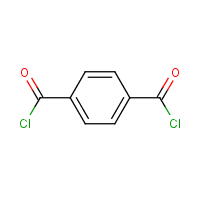1,4-Benzenedicarbonyl dichloride
Agent Name
1,4-Benzenedicarbonyl dichloride
Alternative Name
Terephthaloyl chloride
CAS Number
100-20-9
Formula
C8-H4-Cl2-O2
Major Category
Toxic Gases & Vapors

Synonyms
Terephthaloyl chloride; 1,4-Benzenedicarbonyl chloride; Terephthalic acid chloride; Terephthalic acid dichloride; Terephthalic dichloride; Terephthaloyl dichloride; p-Phenylenedicarbonyl dichloride; p-Phthaloyl chloride; p-Phthaloyl dichloride; [ChemIDplus] UN2928
Category
Acid Halides
Description
Colorless or white solid with pungent odor; [ICSC] White flakes; [MSDSonline]
Sources/Uses
Used in dyes, synthetic fibers, resins, films, pharmaceuticals, rubber chemicals, and as a cross-linking agent for polyurethanes and polysulfides; [HSDB]
Comments
A reproductive effector; Causes asphyxiation by upper airway obstruction after lethal-dose inhalation studies of mice; [RTECS] Dust/air mixture may be explosive; Reacts with water producing hydrogen chloride; A corrosive substance that can cause injury to the skin, eyes, and respiratory tract; Inhalation may cause upper airway edema and pulmonary edema; [ICSC] A skin irritant; [HSDB] Reacts with water; A corrosive substance that can cause injury to the skin, eyes, and respiratory tract; A lachrymator; Inhalation may cause chemical pneumonitis; Effects in high-dose animal studies include lacrimation, changes in renal tubules and other changes to the brain; [MSDSonline]
Biomedical References
Exposure Assessment
Lethal Concentration
LC50 (rat) = 700 mg/m3/4h
Explanatory Notes
The Guide in the Emergency Response Guidebook is for "Toxic solid, corrosive, organic, n.o.s."
Adverse Effects
Lachrymator
Yes
Toxic Pneumonitis
Yes
Dermatotoxin
Skin burns
Diseases, Processes, and Activities Linked to This Agent
Processes
Industrial Processes with risk of exposure: